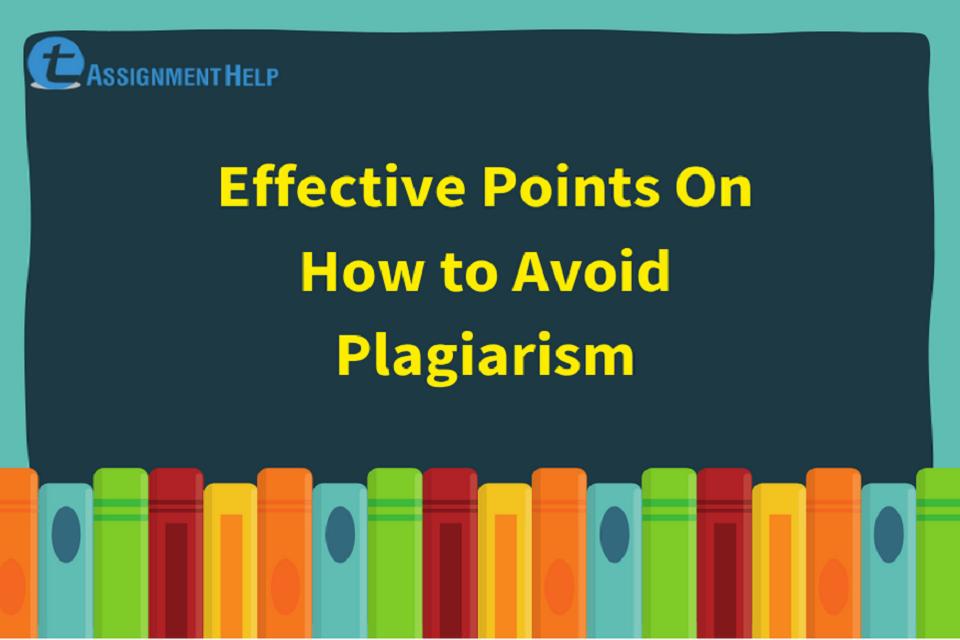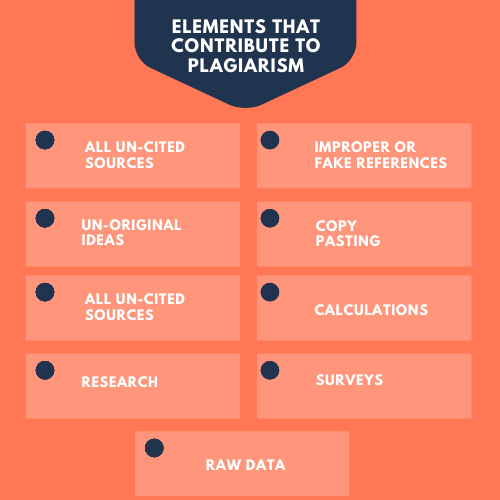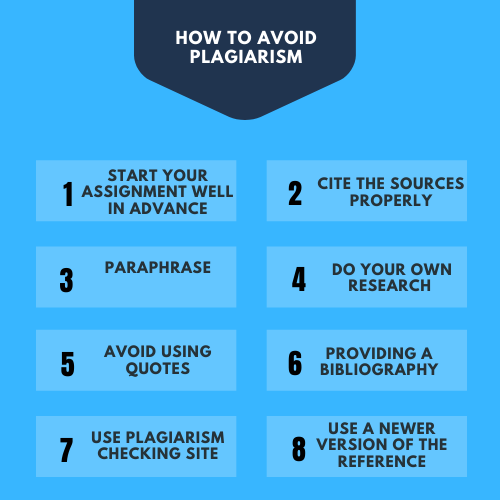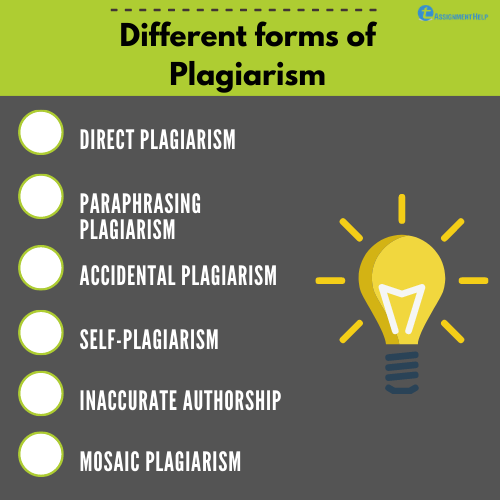Effective Points On How to Avoid Plagiarism

How to avoid Plagiarism is a common question asked by many scholars. Plagiarism is a specific principle, which the tutors and professors keep an eye on. That is why it is necessary that you understand plagiarism carefully in order to avoid getting in serious troubles over it.
In this article you will learn all there is to know about plagiarism, what it is, what are the implications, and how to avoid plagiarism.
What constitutes to plagiarism and how to avoid Plagiarism?
Plagiarism is considered as a serious offence which can land you in some serious trouble if you’re not careful. Plagiarism is passing on someone else’s work as your own, accidently or deliberately. The term ‘work’ here encompasses many things, such as written paragraphs or articles, ideas, calculations, research work, diagrams etc. basically anything which is not yours to publish, or belongs to someone else. In the academic and publishing industry plagiarism equals stealing and fraud.
Every college, University or publishing house has their own rules regarding what they consider as plagiarism. In all of the guidelines, the basic component which are considered as plagiarised content are the same, the only thing that varies is the volume of content from other individuals which is allowed even after giving proper citations.
how to avoid Plagiarism? Understand components that fall under plagiarism:
- All un-cited sources: Information in any form which is not cited to the sources of the information who is the owner of this data, is regarded as plagiarism.
- Improper or fake references: If the cited content is cited to the wrong individual or an some other entity than the one who owns the content is also plagiarism.
- Un-original Ideas: Content based on un-original ideas or concept i.e. information which is written in your document using the principle of other individuals without proper acknowledgement.
- Copy pasting: Straight out copy pasting other people’s content without proper quotation marks or citation is a direct infringement of plagiarism guidelines.
- Images & Diagrams: Images and Diagrams belonging to other people, or even open source images must be acknowledged properly.
- Calculations: Any calculation which is not performed by you and used in any part of the document without giving credit to the person who originally performed the calculation.
- Research: Any kind of research, be it qualitative or quantitative, if it is included in the document, the name of the person who did the research should be given.
- Surveys: Any result or implication which may be derived from a survey conducted by a third person, must be acknowledged in the document. Even if the information is taken from a website, the name of the website should be written.
- Raw Data: Even raw data which is taken from somewhere or someone else can be included in plagiarism.
On the other hand, there are certain instances where no matter how careful you are, you just can’t seem to get the plagiarism in the allowed limit, or in many situations you don’t even have the means to check the plagiarism of your documents.
Not to worry, we have done some digging and come up with 7 effective ways to remove the plagiarism from the document, so that you can avoid getting caught up in some serious trouble, including academic misconduct.
Here is a list of how to avoid Plagiarism or decrease the plagiarism levels:
- Start Your Assignment Well In advance: In order to avoid submitting a poor quality assignment, you should always plan ahead and keep sufficient time in your hands. By starting your assignment in advance you have the freedom to carefully plan your research process, consult with your tutor, make multiple drafts, and submit an assignment which is of superior quality. In most cases the plagiarism in an assignment is due to writing the assignment in a hurry and taking ideas from a number of different sources without even citing them. That is why it is always in your best interest to start working and planning your assignment well in advance.
- Cite the Sources Properly: A citation is the acknowledgement of the source of the information, which in embedded in the text where it is present in the document. It tells the reader about the origin of the information and improves the credibility of the document and supports your claims. Therefore it is important not to forget to give proper citation in the correct format inside the text. Most universities and journals, require you to cite the sources of the information where necessary, and will reject the document entirely if it not done correctly in the assignment.
- Paraphrase: Paraphrasing is a tool which is used my many people in their academic assignments. It means changing the words in a sentence but keeping the essence of the sentence. By paraphrasing the sentences, they do not come up under the plagiarism checking software, but it is still required to cite and give reference to the source of data in any form. Paraphrased content without referencing is still considered as plagiarism, but if the source of the information is ambiguous or unknown then you may use it.
- how to avoid Plagiarism starts by doing research on your Own: Doing your own research and not relying on the works of someone is a good practice as it removes the possibility of plagiarism entirely and also allows you to learn. Doing your research be make the content and the data you in the assignment totally original. You are however allowed to pick up bit of information form some other sources and use it in your research to make your own conclusions, but even then you will be required to acknowledge the source of that information.
- Using Quotes: Using quotes can identify the sentences as being of a different origin than the author of the document. Using quotation marks to encompass sentences which have been taken from somewhere else can save you from getting caught in plagiarism troubles. But keep in mind that even after using quotes it is very important to cite the source of the information right next to the sentence. Most universities and referencing guidelines also have a limit to which you can use cited quotes, which is usually 10% of the total word count.
- Providing a Bibliography: Even after giving in text citation in the document wherever required, it is also important that you provide a bibliography or a reference list which is in the proper format. A bibliography or a reference list contains all the outside sources used in the document to or helped the author to take inspiration for writing a part or parts of the document. There are many formats in which referencing can be done (Oxford, Harvard, APA, MLA etc.), you should ask your tutor or publisher for the one they follow. It is also necessary that give all the required information about the source of the information correctly in the references in the right format. Giving incorrect or falsified referencing can also be included in plagiarism.
- Use Plagiarism checking site: It is hard to get an idea of how much plagiarism your document has even when you are careful and have done everything correctly. The algorithm of the various plagiarism checking sites is such that, it many times related different sentences from various sources and it shows up as plagiarised sentences. This is why you should always check the plagiarism in your written documents throughout the process of writing wherever possible. This gives you an idea of how much plagiarism your file has, you can work on reducing it.
- You can use the plagiarism checker and the reference generator on the Total Assignment Help website, free of cost which will allow you work on your assignments more peacefully.
- Use a newer version of the reference: There is one more thing you can do, which can help in answering the question of how to avoid plagiarism is, using newer and updated reference in your document. If you are picking up an idea or some information for a particular source which may be present there for a while now and it quite popular among others as well, you use the main key words from that source and search for a newer and updated article on the same article and use that in your document after paraphrasing.Many universities specifically ask students to put reference which are not older than 10 years, as the technology and the cultural trends change at a rapid rate. But when it comes to subjects such as law or any other case study, the references are allowed to be old, as they involve a trip down memory lane.
Depending on the source and the way the content in written and framed in the document, plagiarism can be broken into several types, all of which are still considered as unethical academic publishing. Here is a list of various types of plagiarism you should look out for:
- Direct Plagiarism: This is the most severe kind of plagiarism wherein an individual would simply put sections of someone else’ work in their document, without even paraphrasing or using quotation marks. This type of plagiarism is fairly easy to catch, as the words are same and unchanged. This also implies that the individual tried to pass off someone else’s work as their own knowingly and thus will face necessary consequences.
- Paraphrasing Plagiarism: This is the most common form of plagiarism in which, the data or information which is picked up from somewhere, is published in an article without referencing, after changing its words and paraphrasing the whole sentences. This type of plagiarism is not that easy to find, which is why it is so prevalent. It can still be caught through looking for the main key words about the topics which cannot be easily changed, as even after paraphrasing the central meaning of the sentence remains the same.
- Accidental Plagiarism: This kind of plagiarism occurs when an individual forgets to include the citations in their text or if the contents of their document, co-relates to the information present in someone else’s work, unintentionally. This kind of plagiarism is also quite common in University assignments and on the topics which are quite popular among the scholars of the world. However, accidental plagiarism still attracts disciplinary action and penalties. Therefore students must pay attention to this while doing research and properly cite their references.
- Self-Plagiarism: Self-Plagiarism is submitting the same paper again which was submitted by an author at a different source, or using parts or sections of a previous article which was submitted by you and using it again in another article. Using your own content again in a different article also falls under plagiarism.
- Inaccurate Authorship: This type of plagiarism comes from misleading the readers by changing source or putting the name of a different author other than the one who actually wrote the paper. This kind of plagiarism is also an ethics violation, as it takes away the due credit from the deserving individual and gives is to someone else. This form of plagiarism is difficult to trace, as many time multiple publish research papers on a similar topic and contain information which can be considered as general knowledge to individuals who are familiar with the subject.
- Mosaic Plagiarism: This is the most difficult form of plagiarism to detect as it involves putting part and sections of data from someone else’s work and publishing it as their own. It is also known as patchwork or patch writing as it involves, picking up content from different sources and including it in one document.
It is important that you know all about plagiarism and what components it concludes so as to answer the question of how to avoid plagiarism.
Hope is article debunked various misconceptions about plagiarism and provided you with a solution to your problem of how to avoid plagiarism in your paper.






